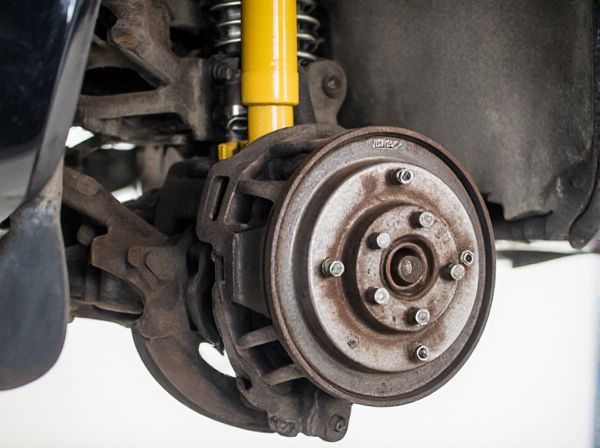
Photo illustration: Limited Slip vs Open
Limited slip differentials provide enhanced traction by distributing power to wheels with the most grip, improving stability on slippery or uneven surfaces. Open differentials allow wheels to rotate at different speeds, offering smooth cornering but less traction in low-grip conditions. Your choice depends on driving needs, with limited slip favoring performance and safety in challenging conditions.
Table of Comparison
| Feature | Limited Slip Differential (LSD) | Open Differential |
|---|---|---|
| Function | Distributes torque to wheels with traction | Distributes equal torque to both wheels |
| Traction | Improved traction on slippery surfaces | Poor traction on slippery or uneven surfaces |
| Performance | Enhances cornering and stability | Standard cornering with potential wheel spin |
| Cost | Higher cost due to complexity | Lower cost, simpler design |
| Maintenance | Requires regular inspection and fluid changes | Minimal maintenance required |
| Ideal Use | Performance vehicles, off-road, slippery conditions | Everyday driving, standard road conditions |
Introduction to Differential Types
Limited slip differentials (LSD) enhance traction by distributing torque to the wheel with more grip, making them ideal for performance driving and off-road conditions. Open differentials allow wheels to rotate at different speeds, which improves handling on regular roads but can lead to traction loss on slippery surfaces. Understanding the key functions of limited slip and open differentials is essential for optimizing vehicle performance and safety under varying driving conditions.
What is an Open Differential?
An open differential is a type of drivetrain mechanism that allows wheels on the same axle to rotate at different speeds, especially useful when turning corners. While it provides smooth handling, it can struggle with traction on slippery or uneven surfaces since power is sent to the wheel with the least resistance. Compared to limited slip differentials, open differentials are simpler and less costly but offer lower performance in off-road or high-traction-demand scenarios.
How Limited Slip Differentials Work
Limited slip differentials use clutch packs or gears to distribute torque between wheels, improving traction by preventing excessive wheel spin on slippery surfaces compared to open differentials. When one wheel loses grip, the limited slip mechanism transfers more torque to the wheel with better traction, enhancing stability and control. This technology is especially beneficial in performance vehicles and off-road applications where maintaining traction is critical.
Key Differences: Limited Slip vs Open Differential
Limited slip differentials (LSD) provide improved traction by distributing torque between wheels more effectively during cornering or slippery conditions, reducing wheel spin compared to open differentials. Open differentials allow wheels to rotate at different speeds but distribute torque evenly, often leading to reduced traction when one wheel slips. LSD systems enhance vehicle stability and performance in off-road or high-performance driving scenarios, while open differentials prioritize smooth handling on regular road surfaces.
Performance Impact on Handling and Traction
Limited slip differentials enhance handling and traction by distributing torque more effectively between wheels during cornering, reducing wheel spin and improving grip on slippery surfaces. Open differentials allow wheels to rotate at different speeds but can cause one wheel to lose traction and result in decreased performance in tight turns or off-road conditions. Performance vehicles benefit significantly from limited slip differentials due to better stability, faster acceleration out of corners, and enhanced control under varying driving conditions.
Applications: Street, Off-Road, and Motorsports
Limited slip differentials enhance traction by distributing torque to the wheel with the most grip, making them ideal for street vehicles facing variable road conditions and off-road use where uneven terrain demands consistent power delivery. Open differentials allow wheels to spin independently, offering smoother turns and reduced tire wear on paved streets but can struggle off-road or in motorsports where maximum traction is critical. Motorsports heavily favor limited slip systems for improved handling and acceleration through corners, while street cars prioritize open or limited slip depending on performance needs and driving environment.
Pros and Cons of Open Differentials
Open differentials offer smoother handling and better maneuverability on dry, paved roads by allowing each wheel to rotate at different speeds during turns. However, their main drawback is poor traction on slippery or uneven surfaces, as power is transferred to the wheel with the least resistance, often causing wheel spin. Compared to limited slip differentials, open differentials are simpler, lighter, and more cost-effective but provide less control and grip in off-road or low-traction conditions.
Advantages and Drawbacks of Limited Slip Differentials
Limited slip differentials (LSD) enhance traction by distributing torque between wheels, improving vehicle stability and cornering performance on slippery or uneven surfaces. Advantages include better power transfer, reduced wheel slip, and increased control during acceleration and turns, especially in performance and off-road vehicles. Drawbacks involve higher mechanical complexity, increased maintenance requirements, and potential for increased tire wear compared to open differentials.
Cost, Maintenance, and Longevity Comparison
Limited slip differentials (LSD) typically cost 2 to 3 times more than open differentials, with prices ranging from $400 to $1,500 compared to $100 to $300 for open diffs. Maintenance for LSDs can be more complex and expensive due to specialized clutches or gears requiring periodic inspection and replacement, while open differentials have simpler, low-maintenance designs. In terms of longevity, open differentials often last longer under normal driving conditions owing to their simpler mechanics, whereas LSDs may experience faster wear when subjected to aggressive or off-road driving.
Choosing the Right Differential for Your Vehicle
Choosing the right differential for your vehicle depends on driving conditions and performance needs; a limited slip differential (LSD) offers enhanced traction by distributing power to the wheels with the most grip, ideal for sports cars or off-road vehicles. In contrast, an open differential allows wheels to rotate at different speeds but can cause wheel spin on slippery surfaces, making it suitable for everyday driving and lighter use. Prioritize an LSD for improved cornering and stability under high torque, while an open differential excels in cost-effectiveness and simplicity.
 caratoz.com
caratoz.com